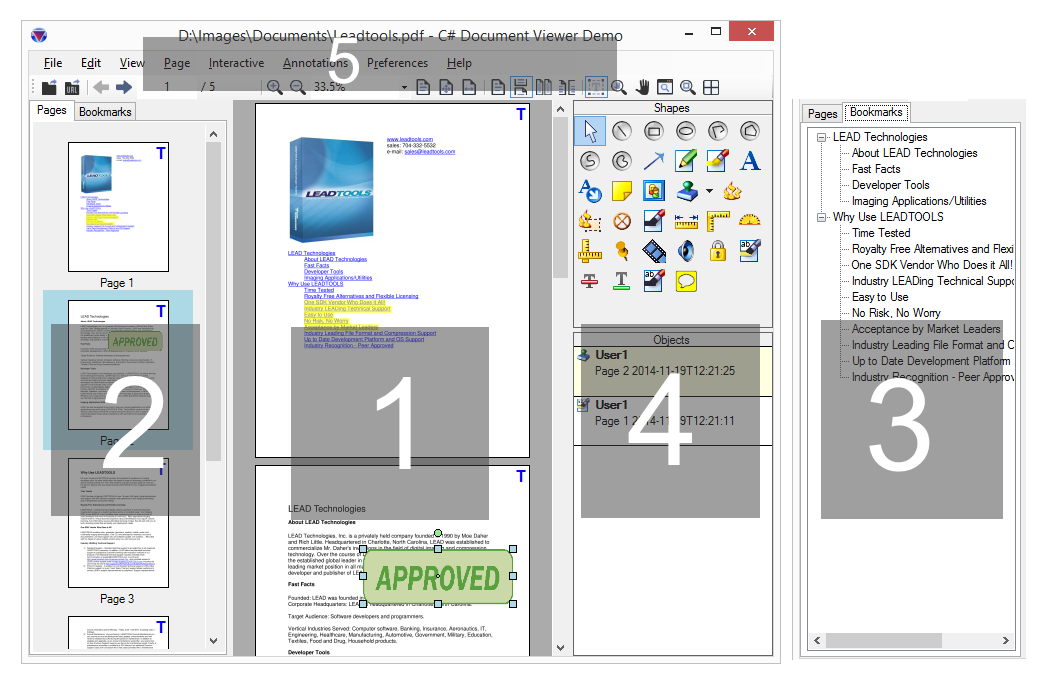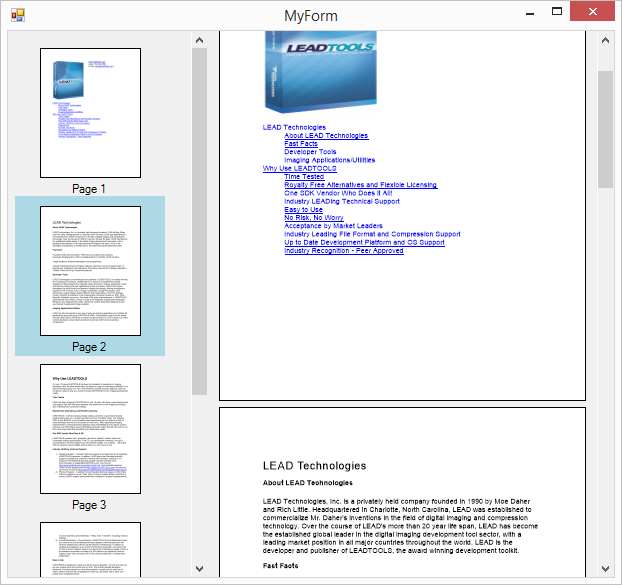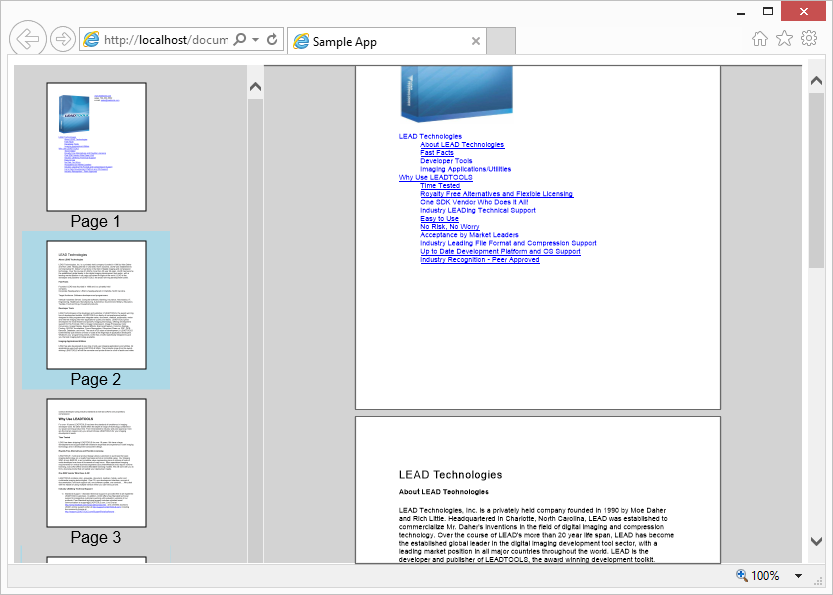Using the LEADTOOLS Document Viewer
Summary
The Document Viewer uses LEADTOOLS Raster and Documents support, Caching, SVG, OCR, Annotations, and Image Viewer technologies to allow creating applications that can view, edit, and modify any type of document on the desktop or web with minimal amount of code.
Features
-
Desktop and Web support - The document viewer supports the Windows Forms platform for desktop applications and includes HTML5/JavaScript libraries for zero-footprint web applications.
-
Fully customizable user interface - The document viewer uses parent containers provided by the user to create the necessary UI controls for easier customization and flexibility.
-
Support for any type of document - The input document is handled by the LEADTOOLS Documents Library which provides a uniform set of programming tools for loading and parsing raster and SVG images, annotations, thumbnails, text data, metadata, and bookmarks from supported document types. These include but not limited to:
-
Adobe Acrobat PDF and PDF/A
-
Microsoft Office DOC/DOCX, XLS/XLSX, and PPT/PPTX
-
CAD formats such as DXF, DWG, and DWF
-
TIFF, JPEG, PNG, EXIF, BMP, and hundreds more raster image formats
-
Plain Text and RTF
-
HTML
-
ePub
-
-
Support for exporting the document to any other format - The viewer can be integrated with the LEADTOOLS Documents Converter to convert any type of document to another with a minimal amount of code.
-
Support for large documents with any number of pages - The viewer uses background threads to load, view, and discard pages on demand to increase performance and preserve system resources. This is performed using caching and virtualization to provide a smooth user interface experience when viewing large documents.
-
SVG and Raster viewing - Support for SVG viewing of any type of document format to provide unlimited and fast smooth zooming without pixelization of text and vector shapes.
-
Annotations and markup support - Read and write annotation objects embedded in documents or from external sources. These include drawing and collaboration text review objects.
-
Free-text search - Uses OCR and SVG technologies to parse text from any type document to support text search and extraction.
-
Rich user interface - Support for mouse and touch devices for panning, zooming, magnifying glass, annotations editing, text selection, and hyper-linking.
-
Document bookmarks and table of contents (TOC) support.
-
Easy-to-use and extensible commands and operations programming interface.
Creating a Document Viewer
DocumentViewer is the main class used by the document viewer. It is not a control itself: instead, it uses parent containers provided by the user to create the necessary UI controls. These containers are native controls in the calling platform - for example, Control in Windows Forms and DIV in HTML5/JavaScript. This allows the application to:
-
Fully customize the viewer appearance
-
Disable any part of the viewer not needed in the application
-
Be independent of any specific UI library since any standard platform control can be used for the container (normal DIV elements in HTML/JavaScript for instance)
The following shows an application that uses the document viewer:

The DocumentViewer has the following parts:
-
View: The part where the main content of the document is viewed. This part is not optional.
-
Thumbnails: The part where the thumbnail of the pages are viewer. This part is optional.
-
Bookmarks: The part where the bookmarks and table of content of the document is added. This part is optional.
-
Annotations: The part where the annotations toolbar and objects list is added. This part of optional.
-
Application User Interface: The rest are the UI elements of the user application and not part of the document viewer. These are typically standard menu and toolbar items that are tied to document viewer commands.
To create a new DocumentViewer in your application:
-
Create a new instance of DocumentViewerCreateOptions and initialize the following members:
-
ViewContainer: Set to an existing control in your application. This is where the main view is created (part 1). The document viewer will create an instance of ImageViewer and add it here.
-
ThumbnailsContainer: Optional: Set to an existing control in your application. This is where the thumbnails is created (part 2). The document viewer will create an instance of ImageViewer and add it here.
-
BookmarksContainer: Optional: Set to an existing control in your application. This is where the bookmarks and table of content is created (part 3). The document viewer will create a tree control and add it here.
-
UseAnnotations: Optional: Set to
trueorfalseto use annotations in the document viewer. The annotation toolbar and automation objects are created after at a later time.
-
-
Call the DocumentViewerFactory.CreateDocumentViewer method passing the create options from the previous step.
After DocumentViewer is created, you can start loading Documents into the control and call the various properties and methods to invoke operations in the viewer.
Loading Documents
The DocumentViewer can view any LEADTOOLS Document object. Refer to Loading Using LEADTOOLS Documents Library for information on how to load any type of document using this class.
Once a Document object is obtained, set in the document viewer using the SetDocument method. The viewer will load the document and populate the view with raster or SVG representation of the pages. If thumbnails, bookmarks or annotations are used, they will be populated by the document viewer as well at this stage.
If the Document being set in the viewer is not read-only, then the viewer will get notified when the Pages collection changes as a result of the user adding or removing pages from the document and update the view, thumbnail, annotations, text, and bookmarks parts accordingly. If multiple pages (from multiple documents even) are to be added or removed from the viewer, then it is recommended to surround the code with DocumentViewer.BeginUpdate and DocumentViewer.EndUpdate to minimize flickering while the viewer updates its parts.
Client-side PDF Rendering
The Document Viewer has support for client-side PDF rendering to enhance performance and reliability when viewing PDF documents and reduces server load. This feature is enabled by default and can be toggled through the DocumentViewer.UsePDFRendering property. In this mode, the document viewer will check if the source document contains any PDF pages, and if so, will not use image/SVG rendering, and instead will render the PDF image data for the page directly on the image viewer and thumbnail surface.
Printing
The Document Viewer supports printing all or a subset of the pages of the document set using standard HTML5/JavaScript printing support, including printing to physical printer devices (local or network) or exporting as PDF. Options include orientation, heading, and whether to show or hide the annotations objects in the final printout. Refer to DocumentViewer.Print for more information.
Example Code
The following examples show the minimal coding needed to create a document viewer and load a document file into it.
Desktop Application
For the Windows Forms platform, create a new Windows Forms application then add the following to Form1:
protected override void OnLoad(EventArgs e){// Create the UI of the application. Two panels, one// for the thumbnails (on the left) and one for the view (fill the form)var viewPanel = new Panel { Dock = DockStyle.Fill };this.Controls.Add(viewPanel);var thumbnailsPanel = new Panel { Dock = DockStyle.Left };this.Controls.Add(thumbnailsPanel);// Create the document viewer using the panels we createdvar createOptions = new DocumentViewerCreateOptions { ViewContainer = viewPanel, ThumbnailsContainer = thumbnailsPanel };var documentViewer = DocumentViewerFactory.CreateDocumentViewer(createOptions);// Set some options, such as Pan/Zoom interactive modedocumentViewer.Commands.Run(DocumentViewerCommands.InteractivePanZoom);// And view the documents as SVG if available - no rasterizationdocumentViewer.View.PreferredItemType = DocumentViewerItemType.Svg;// Load a PDF documentvar document = DocumentFactory.LoadFromFile(@"C:\Users\Public\Documents\LEADTOOLS Images\Leadtools.pdf",new LoadDocumentOptions { UseCache = false });// Set in the viewerdocumentViewer.SetDocument(document);base.OnLoad(e);}

Web Application
For the HTML5/JavaScript platform, create a new HTML file with the following elements in body:
<!--View--><div id="view"></div><!-- Thumbnails --><div id="thumbnails"></div>
Add the following JavaScript code:
window.onload = function () {// Create the document viewer using the DIV elementsvar createOptions = new lt.Documents.UI.DocumentViewerCreateOptions();createOptions.viewContainer = document.getElementById("view");createOptions.thumbnailsContainer = document.getElementById("thumbnails");var documentViewer = lt.Documents.UI.DocumentViewerFactory.createDocumentViewer(createOptions);// Set some options, such as Pan/Zoom interactive modedocumentViewer.commands.run(lt.Documents.UI.DocumentViewerCommands.interactivePanZoom);// And view the documents as SVG if available - no rasterizationdocumentViewer.view.preferredItemType = lt.Documents.UI.DocumentViewerItemType.svg;// Load a PDF documentvar options = new lt.Documents.LoadDocumentOptions();lt.Documents.DocumentFactory.loadFromUri("http://demo.leadtools.com/images/pdf/leadtools.pdf", options).done(function (document) {// Ready, set in the viewerdocumentViewer.setDocument(document);});};
Run the demo in any browser and the viewer is created and is fully functional like its Desktop counterpart. The PDF is loaded and rendered using SVG inside the web browser using native JavaScript code. Both mouse and touch are supported.

